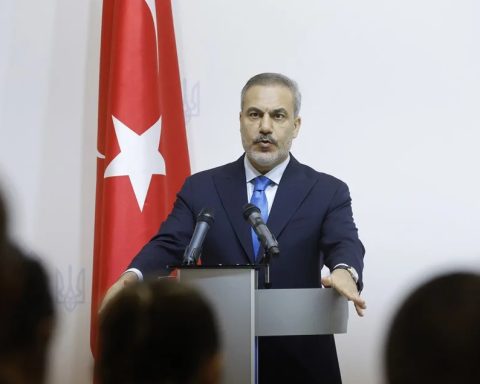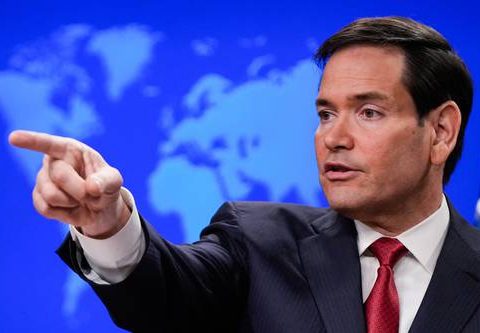Russia’s invasion of Ukraine is close to one year old and there is still no end in sight, which generates uncertainty in the global economic directionmarked by the fluctuations in the prices of products and services such as fuel and transport, fundamental pieces for the operation of the circuit.
In a report published the days after the start of the war, the International Monetary Fund (IMF) anticipated that the effects would be felt in terms of inflation due to food and energy prices; problems in international trade and supply chains; and uncertainty in financial markets.
“Russia and Ukraine are major producers of raw materials, and the shocks caused a spike in world prices, especially oil and natural gas; food costs skyrocketed; wheat, of which Ukraine and Russia export 30% worldwide, reached historical prices”, indicated the IMF.
“Russia and Ukraine are major producers of raw materials, and the shocks caused a spike in world prices, especially oil and natural gas; food costs skyrocketed; wheat, of which Ukraine and Russia export 30% worldwide, reached historic prices”
In this sense, energy prices in the European Union (EU) skyrocketed due to the suspension of gas supply by Russia (main supplier)thus causing one of the biggest energy crises in the region.
Natural gas prices in Europe fell at the end of 2022 to 76 euros per megawatt hour (MWh), very close to the 75 euros registered in December 2021, before the invasion.
Last August, due to the shortage, prices in the EU reached a record high of 350 euros per MWh, before which European buyers managed to cover their supply for the winter, importing liquefied natural gas (LNG) from other countries.
The rise in consumer prices in the United States (USA) led the Federal Reserve (FED) to raise interest rates on February 1 between 4.50% and 4.75%.
According to the IMF, consumer prices climbed 7.3% in 2022 in developed countries, 3.9 percentage points more than what was forecast by the agency in January 2022, and 9.9% (5.9% was estimated ) in the underdeveloped or developing countries.
Indeed, the international price of food continued to drop in January this year, with 131.2 points, and has been falling for 10 consecutive months, according to the latest indicator from the Food and Agriculture Organization of the United Nations ( FAO).
food inflation
For its part, the World Bank (WB), in its latest update on food security, stated that “domestic food price inflation remains high around the world”.
Between September and December 2022, there was “high inflation in almost all low-income (83.3%) and middle-income (90.5%) countries, with 91% of upper-middle-income countries reporting inflation levels above at 5%, and many experience double-digit inflation,” the World Bank said.
Even the price of fertilizers -Russia was until then the main supplier- had an impact, for example, in Spain, where its government will invest 300 million euros to assist farmers in the acquisition of fertilizer for the fields, beyond the fact that the BM will propose a “decrease, but with historically high levels.”

In the United Kingdom (UK), a report by the Bank of England detailed just after the start of the conflict that “world oil prices have increased by 11% and those of wholesale gas in the UK have risen by 40% since the invasion”, while that in March 2022 “British consumer confidence fell to its lowest level since November 2020”.
current sanctions
Regarding the invasion of Ukraine, Russia -like Belarus, for supporting the advance of the country governed by Vladimir Putin- is under sanctions -still in force- against its goods, services and associations imposed by the EU, the UK and the US , among others.
The WB stopped all its activities in that country as of March 2, 2022; credit card companies Mastercard and Visa blocked all transactions linked to Russian institutions on March 1; and the government in Washington ordered all state agencies and authorities to review and divest public funds from Russia; among other similar measures by countries such as Australia and Norway.
operations canceled
The energy companies Exxonmobil, Shell, BP and TotalEnergies canceled their operations and sales to Russia, while Russian gas exports, through their firm Gazprom, fell 25.1% (to 184.4 billion cubic meters) in 2022 as a result of “The refusal of European countries to buy Russian gas, and the sabotage of the Nord Stream 1 and 2 gas pipelines,” said Deputy Prime Minister Alexandr Novak, according to the AFP agency.
However, the official celebrated the “growth potential of gas supply to the Asia Pacific region”, with China in the lead; Thus, sales through the Siberian Force gas pipeline in the Russian Far East grew 48% and reached an all-time high of 15.4 billion cubic meters, Novak said.
Linked to entertainment, firms such as Disney, Netflix, Sony Pictures and Crunchyroll suspended their services in that country; as well as Formula 1, FIFA and UEFA, among other federations, excluded Russian athletes and/or teams from their competitions.
Other sectors that adhered to the boycott were food and beverages, such as McDonald’s, which left Russia on May 16, 2022 and sold all its stores; technology (Apple, Google, Microsoft, among other firms); textiles (Nike, Adidas, Chanel).
The automobile manufacturers Ford, General Motors, Renault, Toyota also joined; of trucks Daimler Truck Holding AG; and Harley-Davidson and Yamaha motorcycles.
Similarly, the shipping and transportation sectors, which also influenced the high costs of freight to Russia: UPS and FedEx suspended their shipments; Maersk, MSC, CMA CGM, Hapag-Lloyd and Ocean Network Express stopped container shipments to Russia, except for basic food items, medicines and humanitarian aid.
How the war impacted the Argentine economy
The war in Ukraine as a result of the invasion of Russia meant an extra cost of US$ 5,000 million for Argentina, due to the fact that the rises in the international prices of the energy sector, fertilizers and freight could not be offset by the increase in the value of agricultural products.
“The war has been having a very high cost for the countries of the southern hemisphere, it has already cost Argentina US$ 5,000 million and there is no global sphere where this issue is being discussed,” the Minister of Economy stated in mid-October last, Sergio Massa.
This calculation, according to Florencia Di Prinzio, an economist at the Center for Political Economy (CEPA), “is based on the multiple impact that the war had on the trade balance, that is, how many extra dollars the country had to spend on imports in the face of the rise in international prices.
To date “the figure does not present significant variations due to an accommodation of international prices,” Di Prinzio remarked to Télam.
Added to this is “the peculiarity that Argentina has an exchange rate regime with many dragging problems, with a doubling, and at a time when devaluation expectations sharpened last year,” the economist director of Sarandí consultant, Sergio Chouza.
“The exchange gap had skyrocketed, reaching levels close to 100% in the second quarter of last year and that caused a delay in exports and affected the flow of export quantities,” he added.
According to official working documents, fuel imports totaled US$5.8 billion at the end of 2022, against the US$2 billion projected in the pre-war period (+US$3.8 billion net increase).
In addition to the cost, the increase in the price of the main basic products required more foreign exchange to import fuels, including those used for the supply of energy during 2022.
For Di Prinzio, the most “significant” variation occurred in this area, with which “almost 75% of the cost of the war is explained by energy imports” from Bolivia (gas) and Brazil (electricity), while “25% The rest is explained by the increase in fertilizers and freight”.
For its part, the Rosario Stock Exchange (BCR) stated in a recent report that “energy imports in our country grew 4% in volume, but due to the rise in prices they grew 100% in dollars (from US$ 7,147 million to US$ 14,138 million), compared to last year”.

















